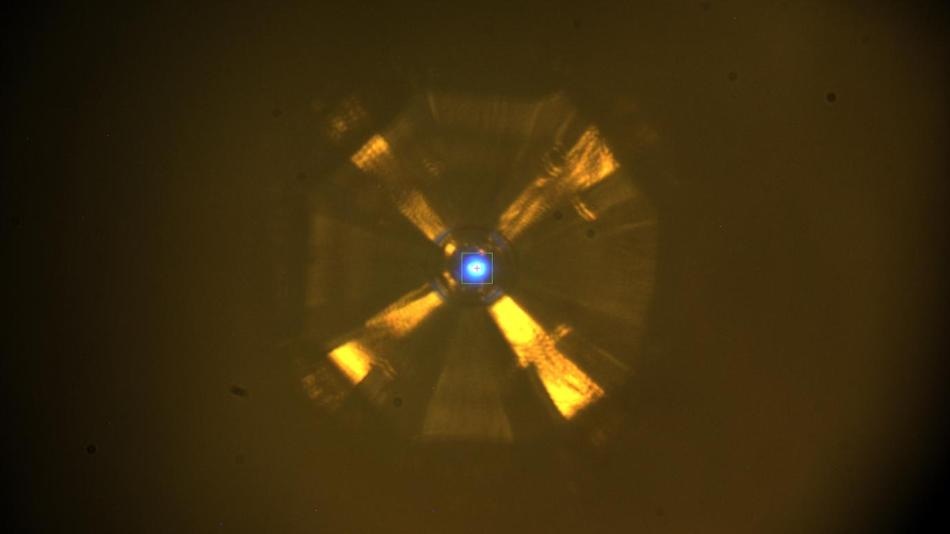May 23 2019
Scientists at the University of Chicago are part of a global research team that has discovered superconductivity—the ability to conduct electricity flawlessly—at maximum temperatures ever documented.
 Scientists bombarded a sample of a new superconducting material (center) with X-rays to study its structure at the Advanced Photon Source. (Courtesy of Drozdov et al)
Scientists bombarded a sample of a new superconducting material (center) with X-rays to study its structure at the Advanced Photon Source. (Courtesy of Drozdov et al)
Using cutting-edge technology at UChicago-affiliated Argonne National Laboratory, the researchers examined a group of materials wherein they witnessed superconductivity at temperatures of about -23 °C (-9 °F)—a jump of about 50° compared to the earlier confirmed record.
Though the superconductivity occurred under very high pressure, the result still signifies a major step toward forming superconductivity at room temperature—the ultimate goal for researchers to be able to use this occurrence for advanced technologies. The results were reported in the May 22nd issue of the journal Nature; Vitali Prakapenka, a research professor at the University of Chicago, and Eran Greenberg, a postdoctoral scholar at the University of Chicago, are co-authors of the study.
Similar to how copper wire conducts electricity better than a rubber tube, some kinds of materials are better at turning superconductive, a state characterized by two key properties: The material provides zero resistance to electrical current and cannot be breached by magnetic fields. The potential applications for this are as massive as they are stimulating: very fast supercomputers, electrical wires without diminishing currents, and efficient magnetic levitation trains.
But researchers have formerly only been able to produce superconducting materials when they are cooled to very cold temperatures—at first, -240 °C and more recently about -73 °C. Since this kind of cooling is expensive, it has restricted their applications in the world in general.
New theoretical predictions have revealed that a new group of materials of superconducting hydrides could make way for higher-temperature superconductivity. Scientists at the Max Planck Institute for Chemistry in Germany partnered with University of Chicago scientists to develop one of these materials, known as lanthanum superhydrides, test its superconductivity, and establish its composition and structure.
The only downside was that the material has to be kept under very high pressure—between 150 Gpa and 170 Gpa, over one-and-a-half-million times the pressure at sea level. Only in these high-pressure conditions did the material—a minute sample only a few microns across—display superconductivity at the new record temperature.
Actually, the material displayed three of the four characteristics required to establish superconductivity: It dropped its electrical resistance, lowered its critical temperature under an external magnetic field, and displayed a temperature variation when some elements were substituted with different isotopes. The fourth characteristic, known as the Meissner effect, wherein the material resists any magnetic field, was not detected. That is because the material is very small that this effect could not be noticed, scientists explained.
The Advanced Photon Source at Argonne National Laboratory was used, which has provided ultra-bright, high-energy X-ray beams to facilitate innovations in everything from enhanced batteries to gaining insight into the Earth’s deep interior, to examining the material. In the experiment, scientists within University of Chicago’s Center for Advanced Radiation Sources squeezed a minute sample of the material between two miniature diamonds to apply the pressure needed, then used the beamline’s X-rays to probe its composition and structure.
As the temperatures used to perform the experiment is within the standard range of many regions worldwide, that makes the critical goal of room temperature—or at least 0 °C—seem within grasp.
The researchers are already continuing to collaborate to discover new materials that can produce superconductivity under more practical conditions.
Our next goal is to reduce the pressure needed to synthesize samples, to bring the critical temperature closer to ambient, and perhaps even create samples that could be synthesized at high pressures, but still superconduct at normal pressures. We are continuing to search for new and interesting compounds that will bring us new, and often unexpected, discoveries.
Vitali Prakapenka, Research Professor, University of Chicago